Daily Brew: October 29, 2025
Welcome to the Wednesday, Oct. 29, Brew.
By: Briana Ryan
Here’s what’s in store for you as you start your day:
- A look at the two gubernatorial offices up for election on Nov. 4
- Signature validity for the 2025 Maine initiatives was 93%
- John Sununu is the third former U.S. Senator running in 2026
A look at the two gubernatorial offices up for election on Nov. 4
There is less than a week to go until Election Day, and Ballotpedia will cover more than 10,000 elections on Nov. 4. To help our readers understand what's at stake, the Daily Brew will feature previews of key elections from now through Election Day. To see what elections we're covering in your area, check out our Sample Ballot Lookup Tool.
Today, we're looking at the two gubernatorial offices up for election. Click below to see our previews on:
- Mayoral elections
- Local battleground elections
- Statewide ballot measures
- Local ballot measures
- Downballot statewide office elections
Currently, 27 governors are Republicans and 23 are Democrats. The following chart shows the national breakdown of party affiliations for each state's governor.
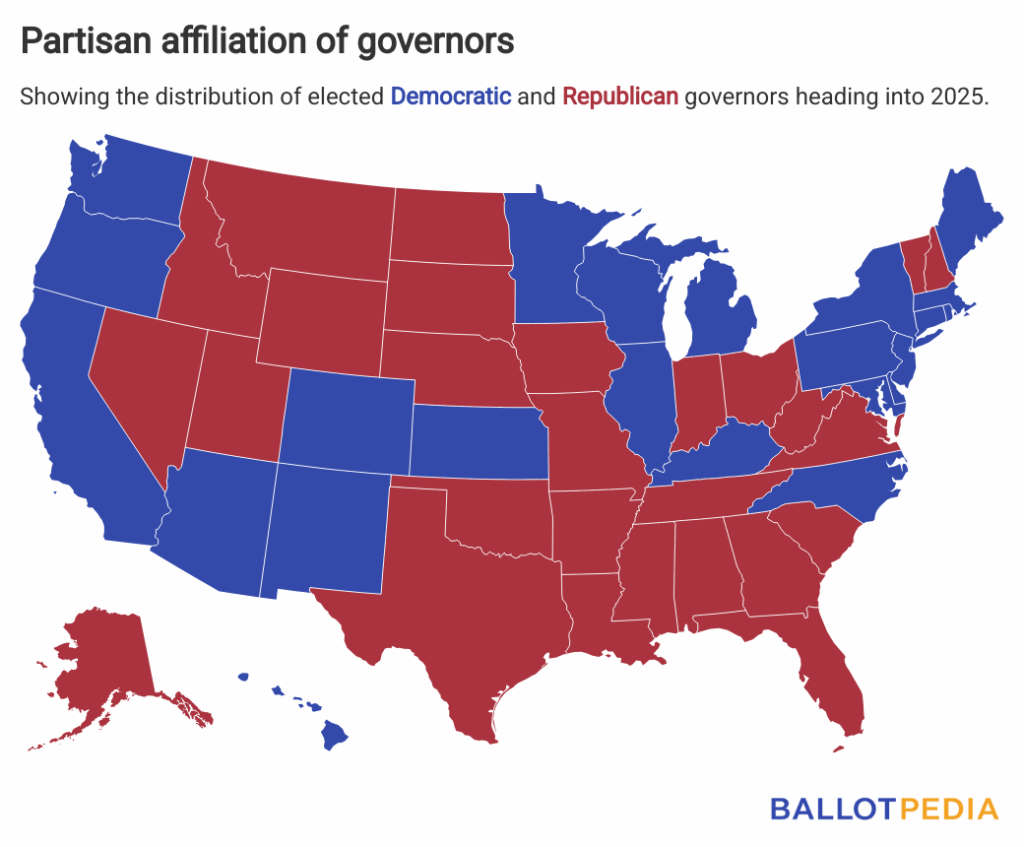
Here's a look at who's running in the states with gubernatorial elections this year and what's at stake in each race.
Mikie Sherrill (D), Jack Ciattarelli (R), Vic Kaplan (L), and Joanne Kuniansky (Socialist Workers Party) are running to succeed incumbent Gov. Phil Murphy (D), who is term-limited.
According to The Washington Post's Hannah Knowles, the election may also give insight into how voters feel about each political party: "Democrats are eager to make the race a referendum on the president and accuse Ciattarelli of cozying up to Trump for political gain. [...] Republicans hope to make it a referendum on liberal leadership in New Jersey."
As of Oct. 28, three independent race forecasters have rated the election as Lean Democratic.
New Jersey is one of 15 states with a Democratic trifecta. The state became a Democratic trifecta when the party gained control of the governorship in 2017.
New Jersey is one of 20 states with a Democratic triplex. The state became a Democratic triplex when the party gained control of the governorship, the attorney general's office, and the secretary of state's office in 2017. New Jersey's governor appoints both its attorney general and secretary of state.
Abigail Spanberger (D) and Winsome Earle-Sears (R) are running to succeed incumbent Gov. Glenn Youngkin (R), who is term-limited.
According to USA Today's Savannah Kuchar, "The Commonwealth is heralded as a national bellwether, like clockwork every four years. Held in the odd year after the presidential election since 1869, Virginia's gubernatorial race is a cyclical scorecard for voters' moods and the issues at the forefront of the national consciousness."
As of Oct. 28, three independent race forecasters have rated the election as either Likely Democratic or Lean Democratic.
Virginia is one of 12 states with a divided government. The state became a divided government when Republicans gained control of the governorship and the House of Delegates in 2021.
Virginia is one of 25 states with a Republican triplex. The state became a Republican triplex when the party gained control of the governorship, the attorney general's office, and the secretary of the commonwealth's office in 2021.
State government trifecta statuses
Nationally, there are 23 states with Republican trifectas, 15 states with Democratic trifectas, and 12 states with divided governments where neither party holds trifecta control. Between 1992 and 2025, the parties achieved the most trifectas, with 18 for Democrats in 1993 and 26 for Republicans in 2018. The following chart shows how many trifectas each party had between 1992 and 2025.
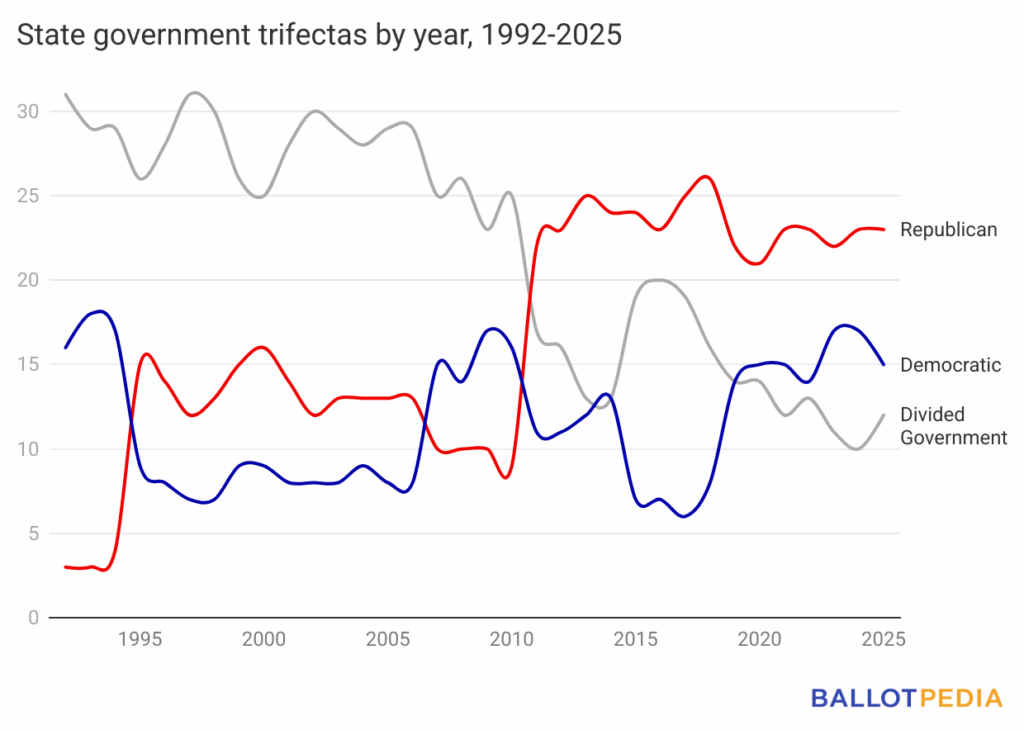
According to Ballotpedia’s annual trifecta vulnerability ratings, there is a moderate possibility of Virginia gaining a Democratic trifecta. To do so, Democrats would need to retain control of the House of Delegates and gain control of the governorship. Since the Democratic-controlled state Senate is not up for election this year, Republicans can not gain a trifecta. For Virginia to remain a divided government, Republicans must at least win control of either the governorship or the state House.
According to Ballotpedia’s annual trifecta vulnerability ratings, the state's trifecta is somewhat vulnerable. To retain their trifecta, Democrats must retain control of the governorship and the General Assembly. Since the Democratic-controlled state Senate is not up for election this year, Republicans can not gain a trifecta. For New Jersey to become a divided government, Republicans must at least win control of either the governorship or the state Assembly.
Click here to read more about trifecta vulnerability in this year's elections, and here to read more about this year's gubernatorial elections.
Signature validity for the 2025 Maine initiatives was 93%
Two citizen-initiated ballot measures will appear on the Nov. 4, 2025, ballot in Maine—Question 1 and Question 2. Proponents of a ballot initiative must submit valid petition signatures from a certain minimum number of registered voters in a state. For 2025, the average signature validity rate was 93.0%, which is both higher than the Maine average between 2017 and 2025 (88.4%) and the highest yearly average nationwide in that time.
The laws governing signature standards differ between the states. However, each requires signatures, at minimum, to be from registered or eligible voters in that state. Other factors that could affect whether a signature is valid or invalid on an initiative petition include where the signature gatherer adhered to the laws governing petition circulators, whether the petition was notarized, or whether someone witnessed the signature.
From 2017 to 2025, Ballotpedia analyzed signature data for 187 initiatives. The average signature validity rate for initiatives certified to appear on the ballot from 2017 to 2025 was 78.8%.
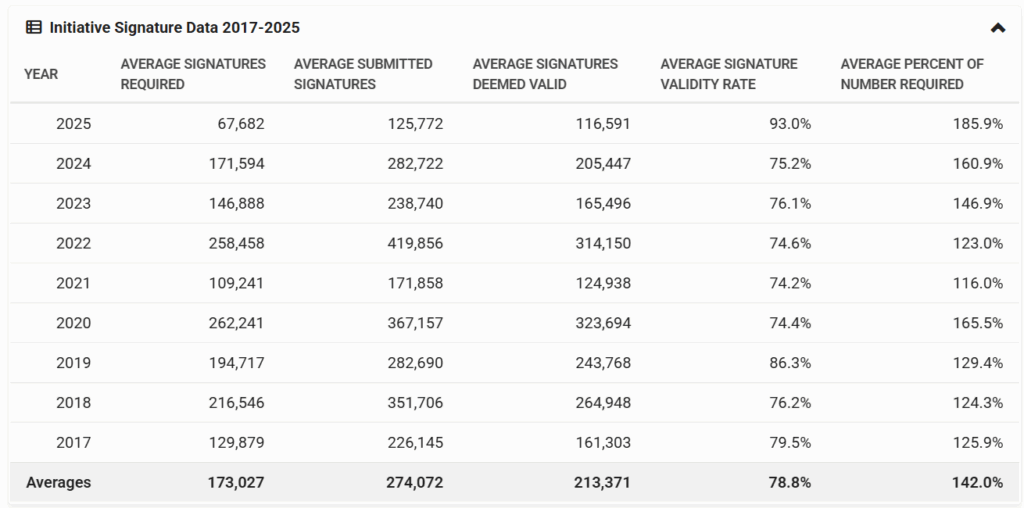
Sponsors of Question 1 submitted 4,410 petition forms containing 171,562 signatures to the secretary of state’s office. The office reviewed the first 2,430 petition forms as the initial sample and found 86,904 valid signatures, 19,222 more than required. This resulted in a 92.3% validity rate. Because the threshold was met, the petition was certified. Applying the same validity rate to all submitted petition sheets, an estimated 158,293 signatures were valid.
For Question 2, the secretary of state’s office reviewed all submitted petition forms. Sponsors filed 79,981 signatures, of which 74,888 were determined to be valid, resulting in a signature validity rate of 93.6%.

This year, the campaigns for initiatives submitted an average of 185.9% of the required number of signatures to place the initiative on the ballot. This is higher than the national average for 2017 to 2025, which is 142%. It is also higher than the Maine average in the same time period, which is 134.6%.
Click here for more information about initiative petition signature validity rates.
John Sununu is the third former U.S. Senator running in 2026
On Oct. 22, former U.S. Sen. John Sununu (R) announced his campaign for the U.S. Senate in New Hampshire in 2026. Incumbent Jeanne Shaheen (D), who defeated Sununu in 2008, is retiring from public office. Sununu’s entrance makes him the third former senator to run in 2026 after Scott Brown and Sherrod Brown (D) in Ohio’s special election for Senate.
In the Republican primary, Sununu will at least face two other candidates, former U.S. Sen. Scott Brown and Tejasinha Sivalingam. On the Democratic side, Karishma Manzur and U.S. Rep. Chris Pappas are running. The filing deadline is June 12, 2026.
Exactly one month before Sununu’s announcement, Ballotpedia looked at the results of former senators running for the U.S. Senate again from 1976 to the present. Sununu is now the 27th senator to run again in 29 elections after leaving office. In the elections that have already happened, a senator lost the general election 13 times, lost the primary five times, withdrew four times, and won four times.
The most recent senator to run again was Jeff Sessions (R-Ala.), who lost in the Republican primary in 2020 after resigning in 2017 to become U.S. Attorney General. The most recent senator to run again and win was Dan Coats (R-Ind.), who left office in 1999, and won another term in 2010.
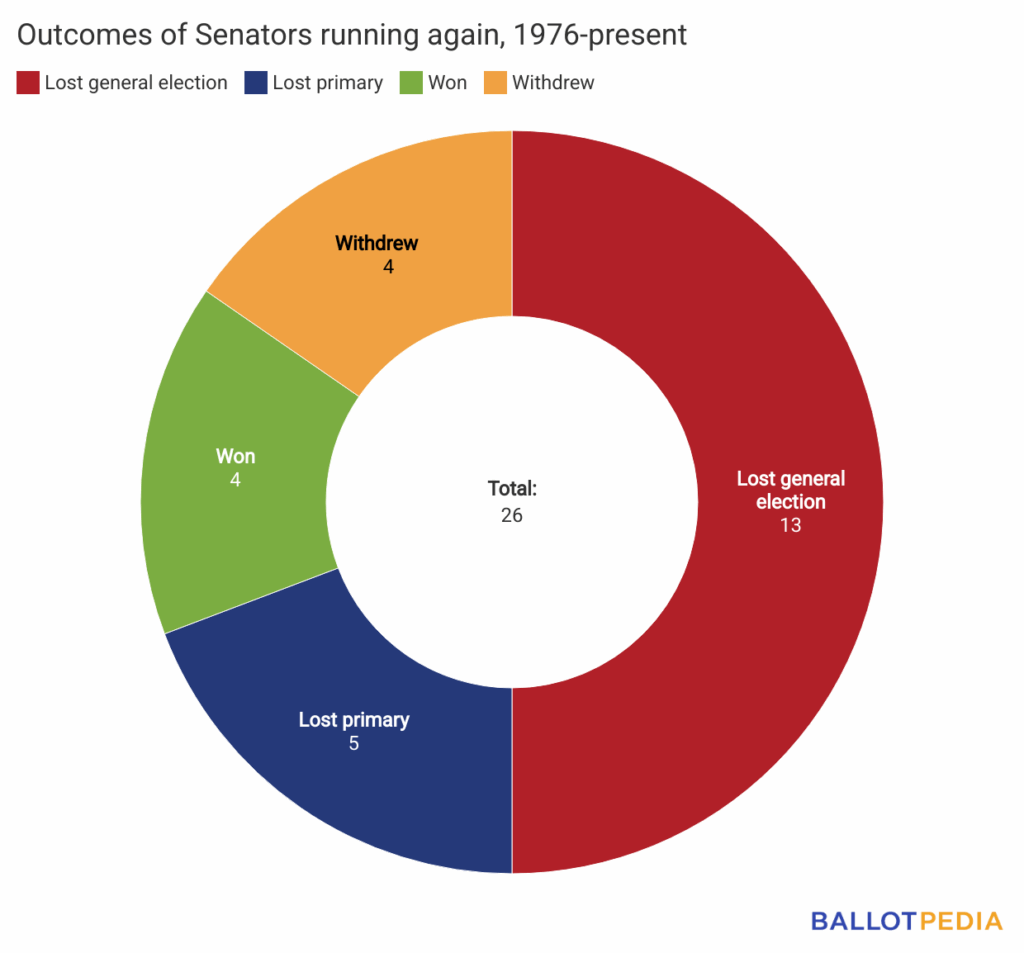
The primary between Brown and Sununu is not the only primary between two senators. In New Hampshire, both Sununu and Brown are former senators. The last time two former senators ran against one another in a primary was in 2014, when Brown and former New Hampshire Sen. Bob Smith (R) ran in the Republican primary for the Senate seat currently up for election. Before Sununu’s announcement, the last year in which more than one former senator ran for another term was 2016, when two Senators, Evan Bayh (D-Ind.) and Russ Feingold (D-Wisc.), ran again.
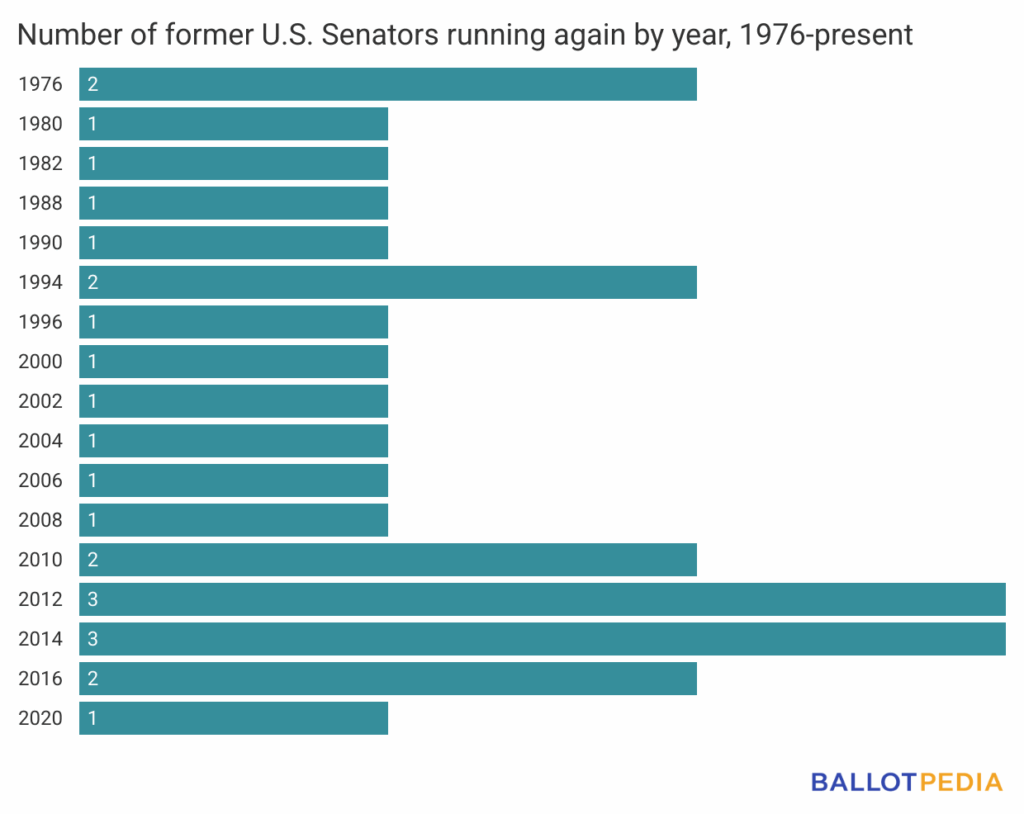
Click here to read more about the 2026 U.S. Senate elections.


